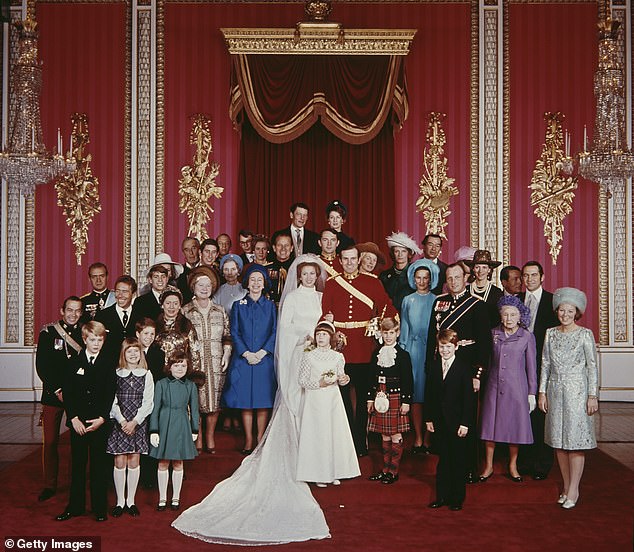The marriage of Princess Anne and Captain Mark Phillips of the 1st Queen’s Dragoon Guards proved groundbreaking in more ways than one.
It took place on November 14, 1973, and was the first televised wedding during the era of widespread television ownership, and was broadcast in color.
More than 500 million people tuned in to the BBC’s eight-hour coverage, including the grand ceremony at Westminster Abbey.
As the first child of Queen Elizabeth and Prince Philip to marry, the day was marked by a lavish celebration, with large crowds lining the streets and an appearance on the balconies afterwards.
This wedding certainly set the standard for the royal nuptials that followed.
Princess Anne’s marriage to Captain Mark Phillips on November 14, 1973 was the first to be televised during the era of widespread television ownership, and was broadcast in color.
Anne first met Captain Phillips at a riding event in Mexico City in 1968.
Both were skilled equestrians and competed at a high level: Phillips was a member of the gold medal-winning eventing team at the 1972 Munich Olympics, while Anne competed for Great Britain at the 1976 Montreal Olympics.
They announced their engagement in May 1973, after Mark proposed with a Garrard-designed sapphire and diamond engagement ring, and they married six months later.
Princess Anne arrived at the ceremony in the glass state coach, accompanied by her father, the late Duke of Edinburgh.
The princess stepped out of her carriage to reveal a Tudor-style wedding dress made by Maureen Baker, chief designer at Susan Small.
The simple design featured a high neckline, delicate pearl embroidery, trumpet sleeves and an extravagant 7-foot-long train.
At the time, scholars claimed that Anne was probably inspired by Queen Elizabeth I, rather than her own mother, Queen Elizabeth II.
She pulled her hair into an elegant bun and secured her veil with the fringed Queen Mary tiara, now the most worn accessory for Windsor brides.
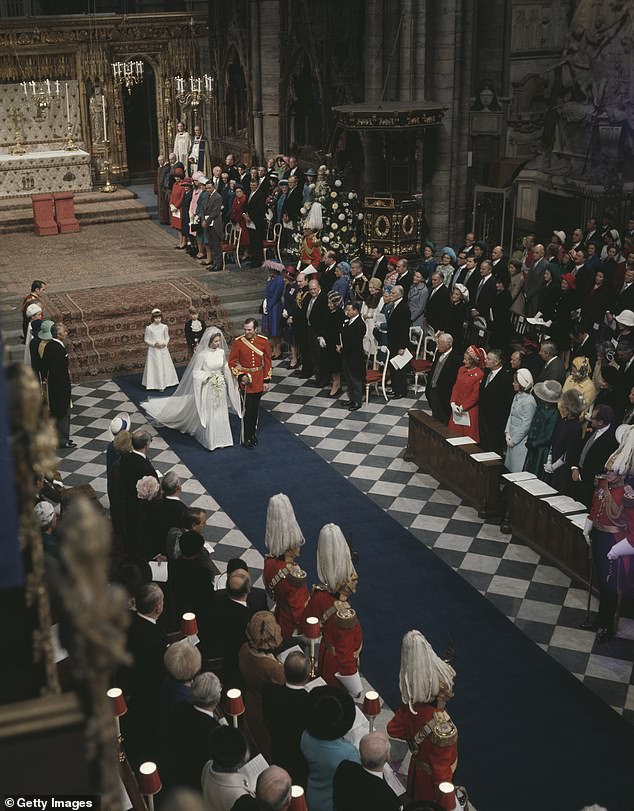
More than 500 million viewers around the world tuned in to the ceremony at Westminster Abbey, demonstrating the appeal of British royal weddings to other countries.
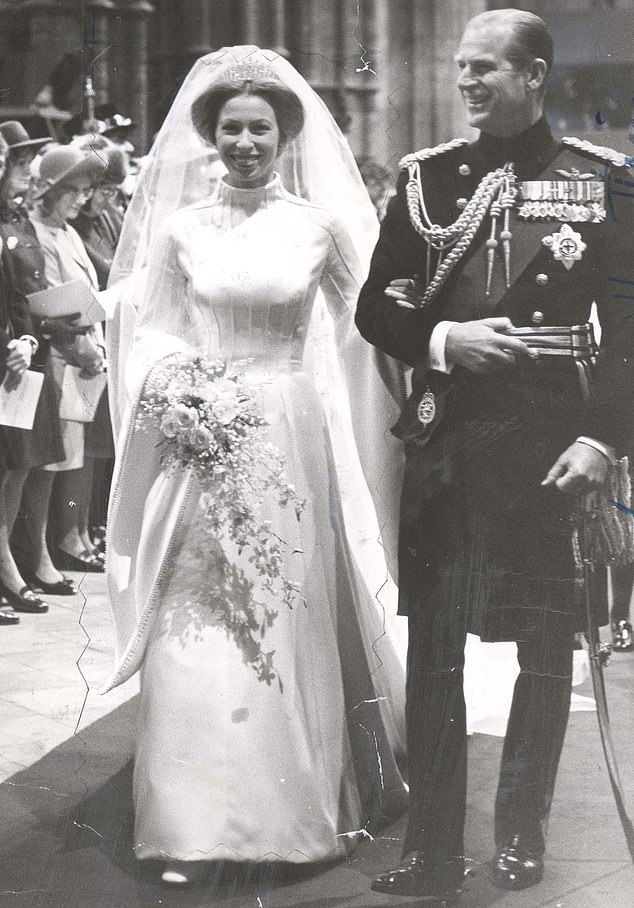
Princess Anne was accompanied to the ceremony at the Glass State Coach by her father, the late Duke of Edinburgh, who then walked her down the aisle.
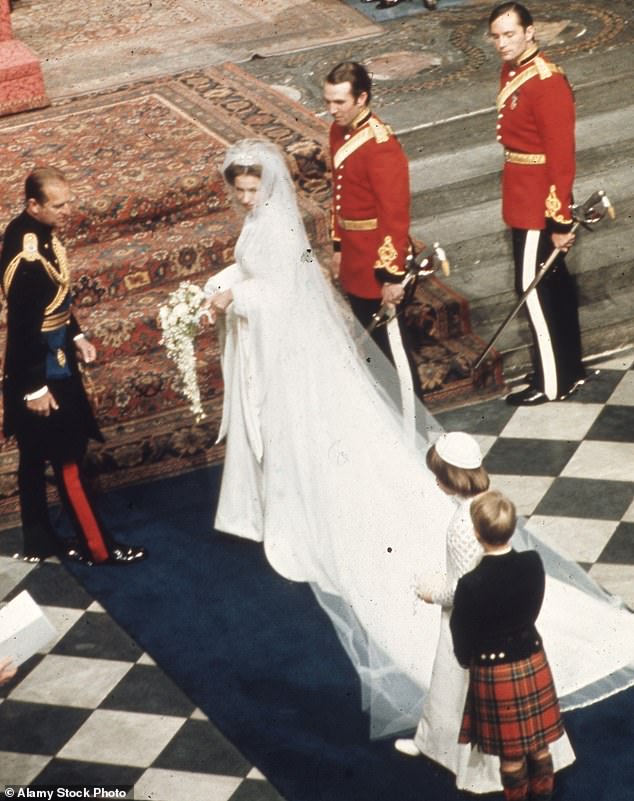
The princess wore a Tudor-style wedding dress made by Maureen Baker, chief designer of Susan Small. At the time, scholars claimed that Anne was probably inspired by Queen Elizabeth I, rather than her own mother, Queen Elizabeth II.
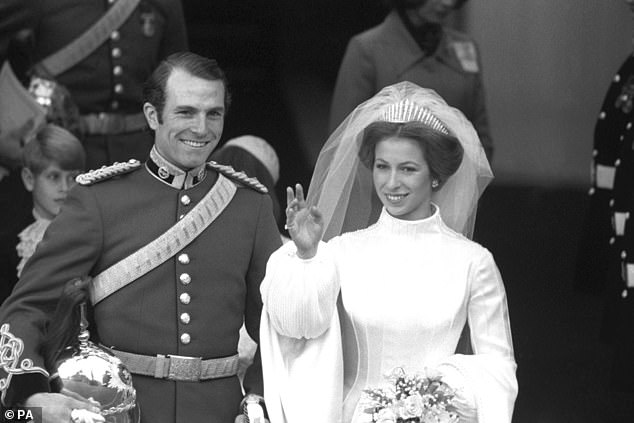
Anne pulled her hair into an elegant bun and secured her veil in place with the fringed Queen Mary tiara, now the most worn accessory for Windsor brides.
Anne’s mother, Queen Elizabeth, had previously chosen the glittering design, made up of 47 graduated brilliant bars set in the shape of a rose, separated by 46 narrower prongs, for her own wedding in 1947.
It had been given to the Queen Mother by her mother-in-law, Queen Mary.
Originally a diamond necklace, made by Collingwood, the dazzling accessory was Queen Mary’s wedding gift from Queen Victoria.
Mary wore the convertible jewel in various ways, including as a headdress, before dismantling it to create a new diamond fringe tiara.
In 1919, he asked Garrard to create a new design in the style of a kokoshnik (a Russian headdress) with diamonds that could be removed to form a necklace.
Princess Beatrice later borrowed the tiara for her private wedding in Windsor to Edoardo Mapelli Mozzi, during the Covid pandemic in 2020.
Anne included a sprig of myrtle in her bouquet, a tradition for royal brides since the 1850s.
This custom began with Princess Victoria, the eldest daughter of Queen Victoria and Prince Albert, in 1858.
Myrtle, which symbolizes love, fertility and innocence, has been grown at Osborne House, Queen Victoria’s holiday home on the Isle of Wight, for around 170 years.
Prince Albert’s grandmother first presented it to Queen Victoria in a posey in 1845, and descendants of this plant still thrive in the house’s grounds today.
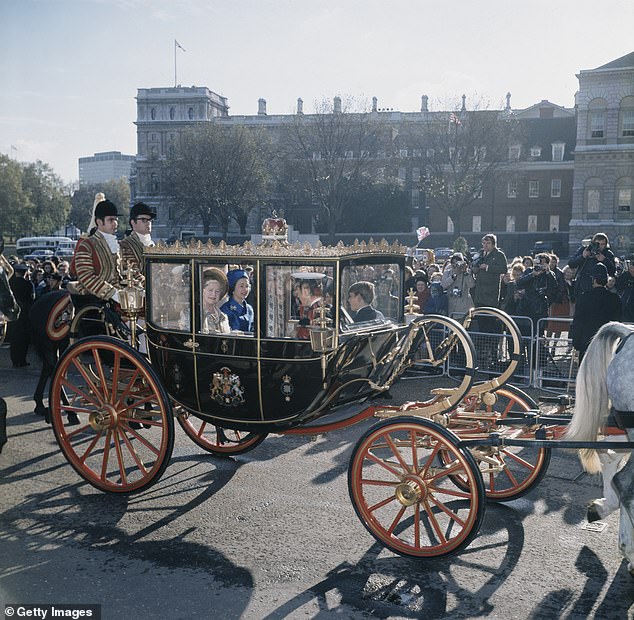
The Queen, the Queen Mother, the Prince of Wales and Prince Andrew arrived at Westminster Abbey on the Scottish state coach.
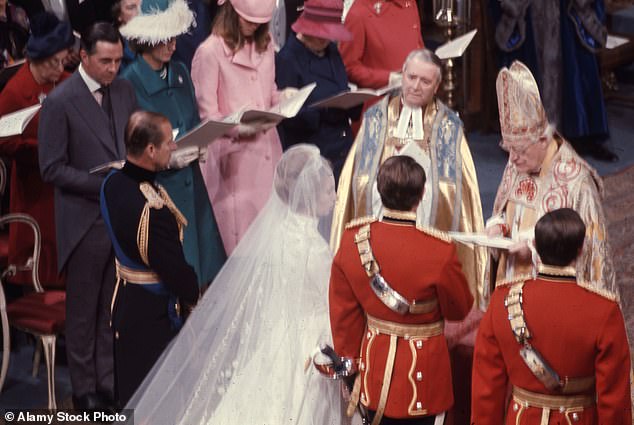
The traditional service, led by Michael Ramsey, Archbishop of Canterbury, was covered during an eight-hour BBC broadcast.
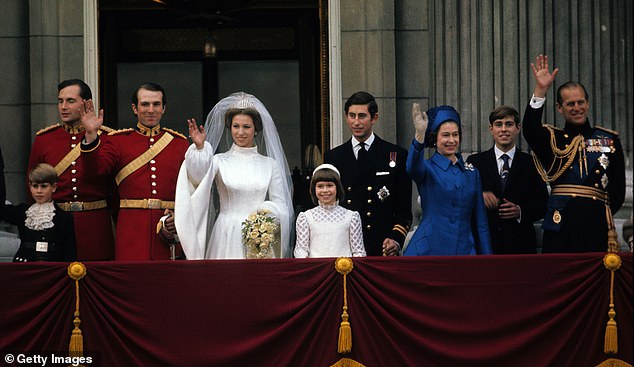
The Royal Family appeared on the balcony before a crowd of supporters who were able to be there because the day was declared a national holiday.
The Queen, the Queen Mother, the Prince of Wales and Prince Andrew arrived on the Scottish state coach.
Princess Anne chose to have only one bridesmaid, her nine-year-old cousin Lady Sarah Chatto (née Armstrong-Jones), daughter of Princess Margaret, while Captain Eric Grounds was the groom’s best man.
The page was Anne’s younger brother, Prince Edward, who was nine years old at the time.
The conventional service, which incorporated choral music and scripture readings, was led by Michael Ramsey, Archbishop of Canterbury.
The Royal Family later traveled to Buckingham Palace and made a jubilant appearance on the balcony to a cheering crowd of well-wishers. The day was declared a national holiday.
In keeping with tradition, Anne’s wedding ring was made from Welsh gold, a practice that dates back to 1923.
Elizabeth Bowes-Lyon, later Queen Mother, first wore a ring made from a gold nugget mined from the Clogau mine in Bontddu, Wales, when she married the Duke of York, later King George VI.
Later, the wedding rings of Queen Elizabeth II, Princess Margaret, Princess Anne and Diana, Princess of Wales were made from the same nugget.
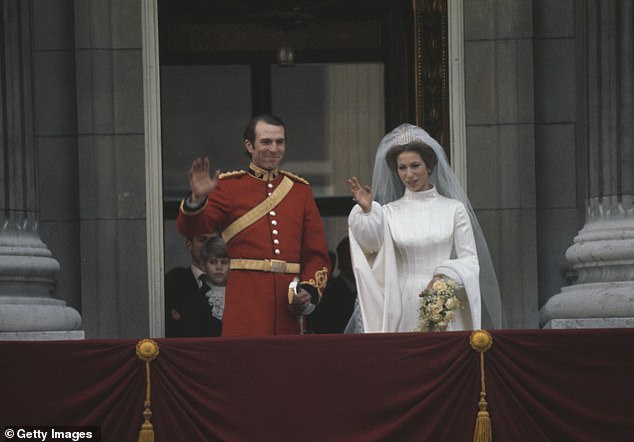
In keeping with tradition, Anne’s wedding ring was made from Welsh gold, a practice that dates back to 1923.
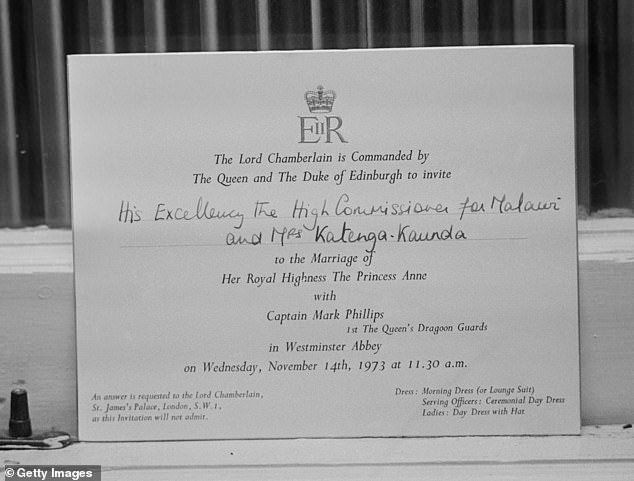
Princess Anne was the first daughter of Queen Elizabeth and Prince Philip to marry and as such, there was much fanfare throughout the day.
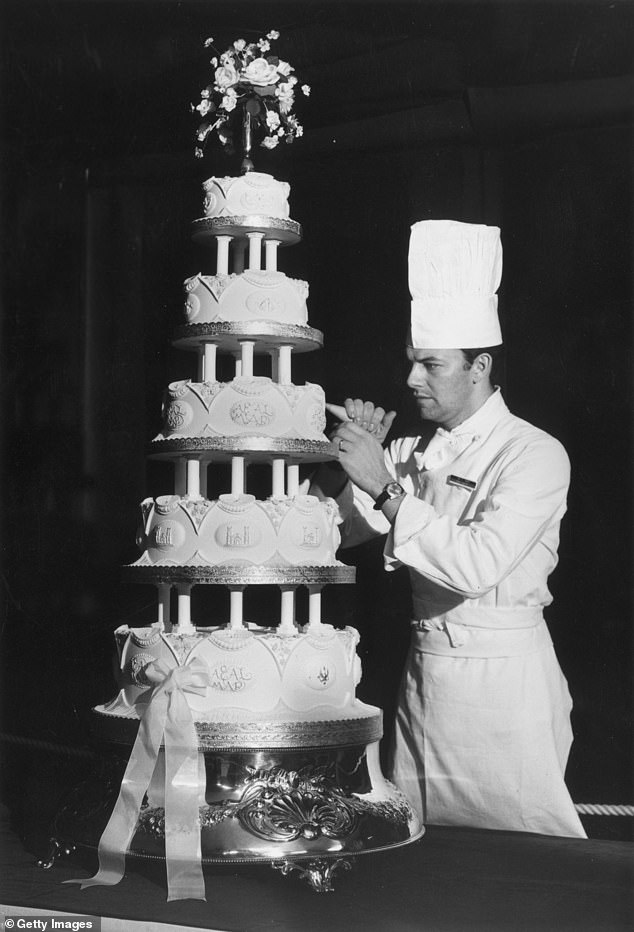
The couple’s wedding cake reached 5 feet, 6 inches (as tall as Princess Anne) and included five tiers of brandy-soaked fruitcake.
After an unconventional wedding breakfast at Buckingham Palace, which included lobster, partridge and mint ice cream, guests enjoyed a slice of cake, which measured 5ft 6in, the same height as Princess Anne.
Made by the Royal Army Catering Corps, the impressive treat featured five tiers of fruitcake that had been soaked in brandy for four weeks.
The cake was decorated with intricate piping and monograms, topped with a statue of a female jockey jumping a fence.
That night, Anne and Mark stayed at White Lodge in Richmond Park, which is now home to the Royal Ballet School, before beginning their honeymoon aboard the Royal Yacht Britannia, traveling the Atlantic and Pacific oceans.
The Queen was said to have offered Captain Phillips an earldom on his wedding day, but he refused it.
This meant that after welcoming their children, Peter Phillips in 1977 and Zara Tindall in 1981, they would be the sovereign’s first grandchildren to be untitled.
Anne and Mark were married for 19 years, before divorcing in 1972 after a long separation.
Anne, who became Princess Royal in 1987, married naval officer Commander Timothy Laurence that same year.
As the Church of England did not allow remarriage after divorce, the ceremony was held in Scotland and only 30 guests attended.


